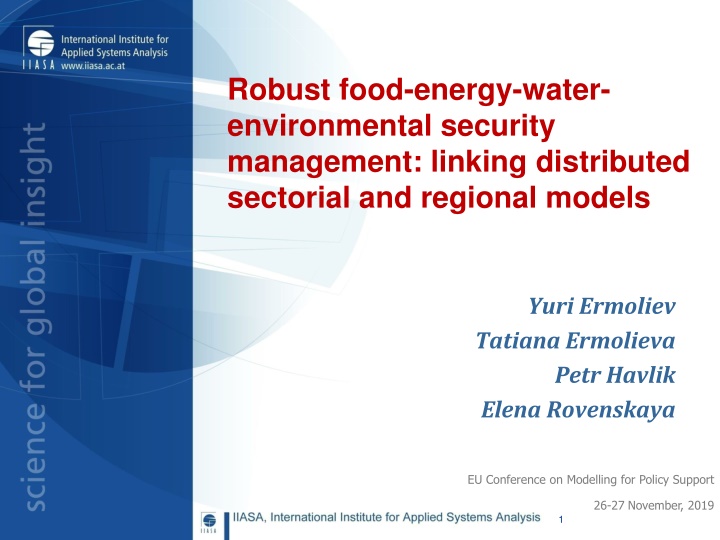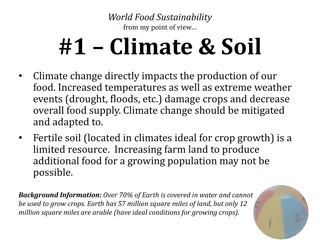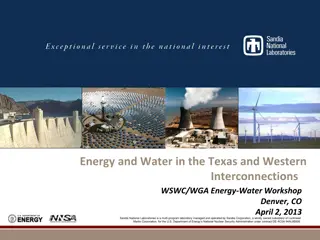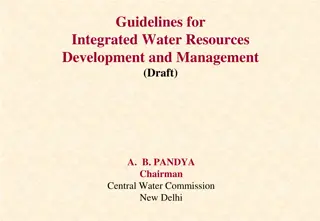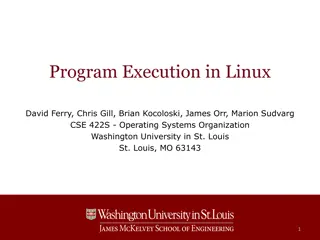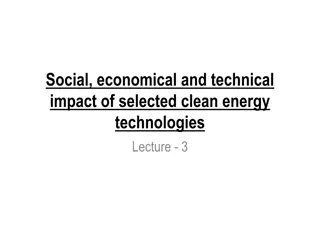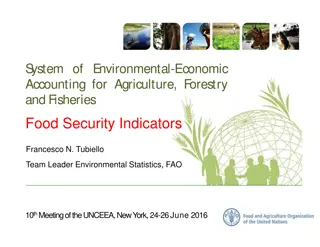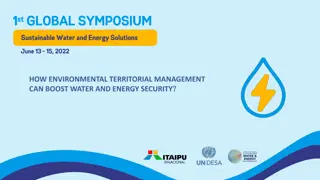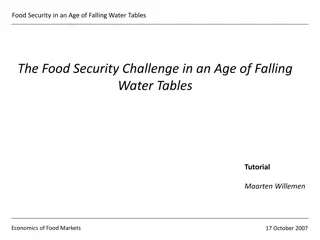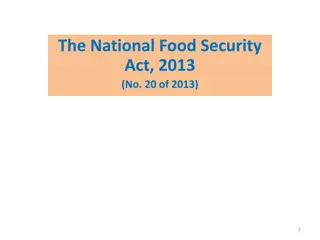Robust Food-Energy-Water-Environmental Security Management: Linking Distributed Sectorial and Regional Models
This presentation explores the complex interdependencies of food, energy, water, and environmental security management. It delves into how these sectors are linked and analyzes systemic threats, risks, and security considerations. The discussion covers energy and food security, supply standards, systemic risks, and the impacts of energy prices on food prices. The focus is on advanced analysis of interdependencies, strategic planning, and the management of uncertainties related to climate change and competition for resources in a multi-dimensional systemic context.
Download Presentation

Please find below an Image/Link to download the presentation.
The content on the website is provided AS IS for your information and personal use only. It may not be sold, licensed, or shared on other websites without obtaining consent from the author.If you encounter any issues during the download, it is possible that the publisher has removed the file from their server.
You are allowed to download the files provided on this website for personal or commercial use, subject to the condition that they are used lawfully. All files are the property of their respective owners.
The content on the website is provided AS IS for your information and personal use only. It may not be sold, licensed, or shared on other websites without obtaining consent from the author.
E N D
Presentation Transcript
Robust food-energy-water- environmental security management: linking distributed sectorial and regional models Yuri Ermoliev Tatiana Ermolieva Petr Havlik Elena Rovenskaya EU Conference on Modelling for Policy Support 26-27 November, 2019 1
Motivation Energy Production Water, energy and food are essential element for human being. Independent plans for: Energy production Food production Water resource allocation Water Resource Allocation Food Production How the sectors are linked?
Advanced Analysis of Interdependencies, Systemic Threats, Multi-Dimensional Systemic risks, and Systemic Security Growing demand vs environmental standards (SDGs); electricity infrastructure innovations and investments; systemic security; increasing returns vs sunk costs; climate change and uncertainty; strategic- and operational planning; long- vs short-term decisions; competition for resources, etc Energy Security Food Security Energy security and water security; supply standards; Energy & water prices; Diversification of energy supply; Ex-ante and ex-post risk management; electricity supply security; global and local threats to electricity supply systems; endogenous risks; cyberattacks; protection of critical infrastructure Incomes; economic and population growth; demand changes; life and nutrition standards; prices; Impacts of energy prices on food prices; Dependencies between agricultural and energy markets through bio-fuels; Agricultural subsidies; renewables subsidies, etc. Nested multi-model welfare analysis and systemic security management Socio - Economic Security Water Security Control of water resources; reliability vs. disasters; Monitoring of infrastructure reliability; monitoring of water resources vulnerability and accessibility; Monitoring & control of water contamination; 3, date
New threats, new risks, new challenges: Risk-Based Decision Making Standard risks Generated by exogenous events Historical observations characterise risks by probability distributions Risk assessment is used for risk management Statistical decision theory, expected utility theory, cost-benefit analysis, levelized costs, annualization of profits or losses, etc. Unknown (systemic) risks Catastrophic risks, missing observations Interdependencies Unknowable (systemic) threats, risks, and security management New interdependent systems, missing observations Endogenous risks Risks generated by decisions of agents Blackouts of energy system due to natural disasters, triggered by rains, hurricanes, and earthquakes in combination with inappropriate land use planning, maintenance of flood protection systems and behavior of various stake holders High GHG goals, energy prices and volatility, global climate change concerns create high demand for biomass The need to design new systems, which are robust against possible unknown and unknowable risks 4, date
Examples of linkages: representation of the energy- water nexus, UK 5, date A. Majid, T. Ermolieva, Y. Ermoliev et al., 2018-2019
Example of distributed models linkage: a robust distributed local- global network system, IIASA-NASU FWEES Security Project 6
Linkage of distributed energy-agriculture-water models Coal related industry Cooling technology Power Waste water treatment dry quenching coke Power reuse Waste water treatment Coal Mining Water resource Quantity Water resource Quality Coal quantity Dry/reuse of water Drainage water Agriculture Crop stucture crop quantity Air Pollution 7, date
Coal in China Energy consumption Structure in 2012 Coal Production in 2012 Others 0.292 Energy security Xinjiang 0.139 1.95 5% Shanxi 0.914 0.22 1% 6.81 19% Anhui 0.147 67% of total consumption in China 23.96 66% Inner Mogolia 1.062 Shannxi 0.427 3.26 9% Yunnan 0.104 Shanxi produce 26% coal in 2012 Guizhou 0.181 Henan 0.147 Shandong 0.145 About 64% coal exported to other Coal Renewable crude oil Hebei 0.092 Unit: Billion Tons Gas Nuclear 0 0.2 0.4 0.6 0.8 1 1.2 provinces (5.8/9.1) About 80% GDP from coal related industry in Shanxi Serious environmental, social, and economic impacts Unsustainable development 8, date
Water shortage 83% of China s coal lies in water scarce and water stressed regions. Geographical mismatch between water availability and coal industry Source: Pan, Y., et al. (2012) 9, date
Energy-water-food security, Shanxi province, China Xu, X., Gao, J., Cao, G.-Y., Ermoliev, Y., Ermolieva, T., Kryazhimskiy, A.V. and Rovenskaya, E. (2015): Modeling water-energy-food nexus for planning energy and agriculture developments: case study of coal mining industry in Shanxi province, China. IIASA Interim Report 15-020 Coal (energy) vs. crops Tight water constraints 11 locations (prefectures) Sector-specific constraints on production Demand supply equilibrium Stochastic agro-energy demand Stochastic water supply Joint constraints on water consumption and land use Stochastic water supply 10, date
Model of sector/region E Model of sector/region A Minimizing costs , min x c x , min x c x Constraints on volume of production Constraints on available resources (land, water, etc.) E E A A A A R x R x E E x E A A x A M y M y E E E A A A y y 0 x D 0 x D E A d d A A A E E E Can be separated for simplicity but in reality are inter-linked!d + D y D y A A E E
Nave approach: direct iterative exchange between models + ) 1 + ( 1 ), ( x k y k A A , min x c x , min x c x E E A A A A ( ), ( ) x k y k R x R x E E E E x E A A x A M y M y E E E A A A (k ) yE + + ( ) 1 D y D y k d 0 x 0 x A A E E E A (k ) yA + ( ) D y k D y d A A E E + D y D y d A A E E
Nave approach: example dependence on the initial condition! , min x c x , min x c x E E A A A A R x R x E E x E A A x A M y M y E E E A A A 0 x 0 x E A + D y D y d A A E E
Hard linking approach: minimization of the overall welfare function + , , min c x c x A A E E Ax , x E A x R x R x A A E E x E M y M y A A A E E E 0 x 0 x A E + D y D y d A A E E Implementation may be challenging computing time, needs to re-code etc.
Linking models via a central hub under uncertainty and asymmetric information = + ) 0 ( ( 0 ( ), 0 ( )) : ) 0 ( ) 0 ( y y y D y D y d A E A A E E + , , ( ) min , u E u y k + , , ( ) min , u A u y k E E E E A A A A E A + R u M c + R u M c E E E E E A A A A A , 0 0 u , 0 0 u E E A A (k ) (k ) A E ) 1 + = + ( ( ( ) ( ) ( )) y k y k k k A Y A A ) 1 + y = y + ( ( ( y ) ( ) ( d )) y y k y k k k E E E E = + {( , : ) E , , 0 0 } Y D D y y A A A E E A E
Convergence theorem =1 k = = ( ) 0 : ( ) , 0 , ( ) k k k k Let = Then * * A * E ( ) ( ( ), ( )) ( , ) y k y k y k y y y A E + y = * * Ay * , , min , x E c x c x ( , : ) E y where A A E E , , x y y A A E & R x R x A A x A E E x E y & M y M A A A E E E 0 & 0 x x A E 0 & 0 y y A E Yuri Ermoliev (1988), Yuri Ermoliev et al. ( 2017, 2019) for Deterministic and stochastic cases
